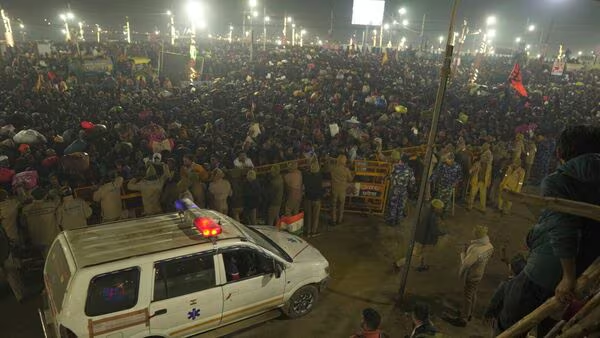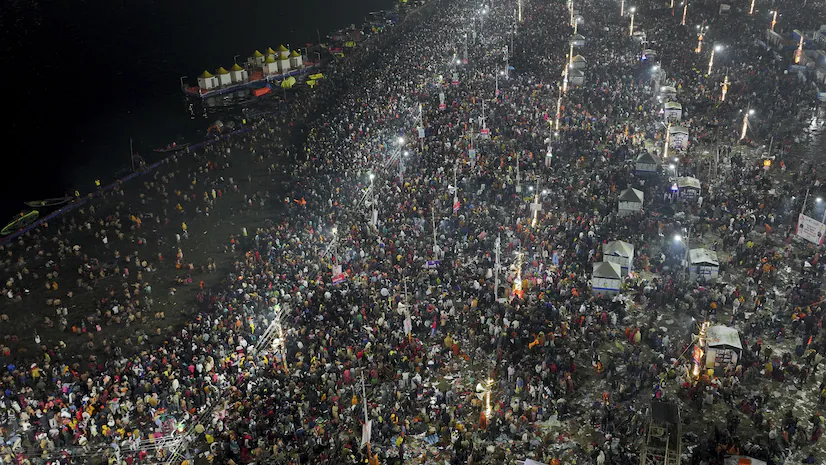
Tragic Stampede at Maha Kumbh Festival A devastating stampede at the Maha Kumbh Festival in Prayagraj, India, has resulted in the loss of at least 30 lives, with many others injured. The tragedy unfolded when an overwhelming crowd surged toward the riverbanks for the holy dip, causing chaos and panic among devotees. Despite security measures in place, the sheer number of attendees led to a breakdown in crowd control, resulting in the unfortunate incident. Authorities and emergency teams responded swiftly, but the intensity of the situation made rescue operations challenging.
The Maha Kumbh Festival, one of the largest religious gatherings in the world, attracts millions of devotees from across India and beyond. Pilgrims gather to bathe in the sacred waters, believing it will cleanse their sins and bring them closer to salvation. However, such massive gatherings require well-coordinated security and crowd management strategies. This tragic event raises concerns about the effectiveness of safety protocols and the need for better infrastructure to prevent similar disasters in the future.
1. The Significance of Maha Kumbh Festival
The Tragic Stampede at Maha Kumbh Festival Festival holds deep spiritual and cultural significance in Hinduism. Celebrated every 12 years at four different locations—Prayagraj, Haridwar, Nashik, and Ujjain—it is considered the largest peaceful gathering on Earth. Devotees believe that taking a dip in the sacred rivers during Kumbh purifies their souls, erases past sins, and grants them spiritual enlightenment. This faith-driven pilgrimage has been a tradition for centuries, attracting saints, sadhus, and pilgrims from all walks of life.
Apart from its religious importance, the Tragic Stampede at Maha Kumbh Festival is also an event of historical and social relevance. It showcases India’s rich heritage, uniting millions in a shared spiritual journey. The festival also boosts local economies, with businesses and vendors catering to the needs of pilgrims. However, the sheer scale of the event demands meticulous planning and safety measures to ensure the well-being of attendees. The recent Tragic Stampede at Maha Kumbh Festival highlights the pressing need for better crowd management and improved safety infrastructure at such large-scale religious events.
2. Challenges in Crowd Management at Religious Gatherings
Tragic Stampede at Maha Kumbh Festival Managing millions of people in a confined space presents enormous challenges, even with well-structured planning. At the Tragic Stampede at Maha Kumbh Festival Festival, crowd control requires efficient coordination between authorities, police forces, and volunteers. Unfortunately, despite precautions, unpredictable situations such as sudden crowd surges can lead to disasters like stampedes. Insufficient exit points, lack of proper barricades, and the unpredictable movement of devotees contribute to such tragic incidents.
Stampedes at religious events have occurred multiple times in India due to similar reasons. Overcrowding, limited infrastructure, and panic-driven movement often escalate into deadly situations. To prevent such Tragic Stampede at Maha Kumbh Festival in the future, authorities must invest in advanced crowd control techniques, including real-time monitoring, AI-powered surveillance, and well-defined emergency response protocols. The use of technology and stricter regulations can help manage large gatherings more effectively and reduce the risk of such unfortunate incidents.
3. Government’s Response and the Road Ahead
Following the tragic stampede, the Indian government has launched an investigation into the causes of the incident and the adequacy of safety measures in place. Officials have assured the public that necessary steps will be taken to prevent such disasters in the future. Tragic Stampede at Maha Kumbh Festival Immediate relief efforts, including medical assistance for the injured and financial aid for the families of the deceased, have been announced. However, the bigger challenge lies in implementing long-term solutions to enhance safety at massive public gatherings.
Going forward, authorities must adopt a proactive approach by enforcing stricter crowd control policies and utilizing modern technology. Establishing designated entry and exit points, deploying more security personnel, and using drones for real-time monitoring can significantly improve safety standards. Additionally, educating pilgrims about safe movement in crowded spaces can reduce panic-induced incidents. With better planning and execution, India can ensure that future Kumbh Melas remain a spiritual celebration rather than a scene of tragedy.
4. Lessons Learned from the Tragedy
The Tragic Stampede at Maha Kumbh Festival stampede serves as a grim reminder of the vulnerabilities in managing massive religious gatherings. While faith and devotion bring millions together, safety must remain a top priority. This incident underscores the urgent need for improved event planning, better coordination between authorities, and increased public awareness about crowd behavior.
Learning from past incidents, India must integrate technological advancements in crowd management. Implementing AI-based monitoring systems, training more volunteers, and designing better infrastructure will be crucial in ensuring that such tragedies do not recur. The Maha Kumbh Festival should remain a symbol of spiritual unity and peace, not a place of sorrow and loss. By prioritizing safety, authorities can honor the faith of millions while preventing future disasters.
Buy Domin and Hosting with our trusted websites
https://www.hostinger.in/
https://www.bluehost.com/




Leave a Reply